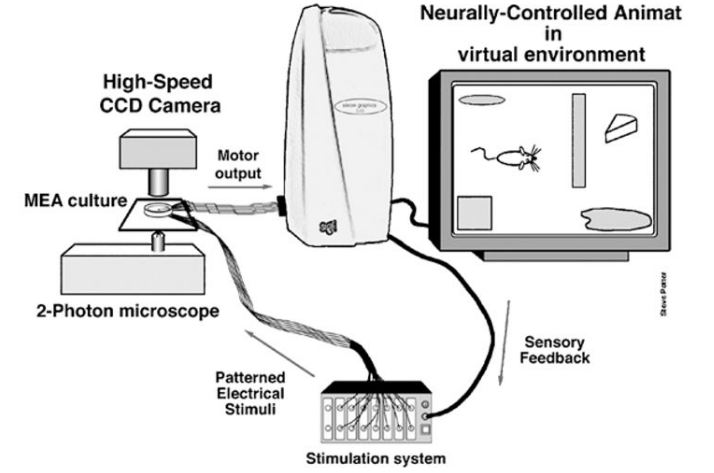Network of brain cells models smart power grid
April 30, 2013

A network of hundreds or thousands of dissociated mammalian cortical cells (neurons and glia) are cultured on a transparent multi-electrode array. Activity is recorded extracellularly to control the behavior of an artificial animal (the Animat) within a simulated environment. Sensory input to the Animat is translated into patterns of electrical stimuli sent back into the network. (Credit: Thomas B. Demarse et al./Autonomous Robots)
A team of neuroscientists and engineers at Clemson University is using neurons grown in a dish to control simulated power grids.
The researchers hope that studying how neural networks integrate and respond to complex information will inspire new methods for managing the country’s ever-changing power supply and demand.
“The brain is one of the most robust computational platforms that exists,” says Ganesh Kumar Venayagamoorthy, Ph.D., director of the Real-Time Power and Intelligent Systems Laboratory y.
“As power-systems control becomes more and more complex, it makes sense to look to the brain as a model for how to deal with all of the complexity and the uncertainty that exists.”
America’s strategy for providing power began in the late 1800s as a number of isolated generating plants serving regional customers. Over the next 50 years, the electric system was rapidly transformed into an inter-connected “grid” that ensured access to power when equipment failed or during periods of unexpected demand.
Today, with nearly 200,000 miles of high-voltage lines connecting over 6,000 power plants, America’s power grid has been called the world’s largest single machine.
Unfortunately, the grid’s aging infrastructure wasn’t built to handle today’s ever-increasing demand. According to the U.S. Department of Energy, the average power generating station in the United States was built in the 1960s, using even older technology. Today, the average substation transformer is 42 years old, two years past its expected life span.
Another problem is that while the system has a great capacity to produce power, it doesn’t actually have a way to store power.
This can spell trouble during periods of unexpected high demand, which can result in a massive loss (blackout) or reduction (brownout) in electricity. In 2003, 50 million people in eight states and one Canadian province were left without power when a single transmission line in Ohio was damaged by a tree limb.
Tomorrow’s power grid will need to be able to anticipate usage and quickly compensate for unexpected need.
The “on-demand” power production strategy of our current system also makes it difficult to incorporate renewable sources of energy, such as wind and solar power, which can’t be cranked up or down in response to peaks and lulls in power consumption.
A smarter electric power grid
“In order to get the most out of the different types of renewable energy sources, we need an intelligent grid that can perform real-time dispatch and manage optimally available energy storage systems,” says Venayagamoorthy.
While technologies such as solar panels, wind turbines and hybrid electric vehicles will help reduce our non-renewable energy consumption, experts believe the development of a “smart” grid, capable of monitoring and controlling the flow of electricity from power plants down to individual appliances, will have the largest impact.
According to the Department of Energy, if the current grid were just 5 percent more efficient, the energy savings would be equal to removing 53 million cars from the planet.
While a number of strategies have been proposed to optimize grid performance and incorporate intermittent energy sources, the ultimate goal is to create a distributed energy delivery network characterized by a two-way flow of electricity and information.
“What we need is a system that can monitor, forecast, plan, learn, make decisions,” says Venayagamoorthy. “Ultimately, what we need is a control system that is very brain-like.”
Role of the brain
Because the brain operates in a completely different way than traditional computing systems, the first step was to try to make sense of how the brain integrates and responds to data. To do so, Venayagamoorthy enlisted the expertise of neuroscientist Steve Potter, Ph.D., director of the Laboratory for NeuroEngineering at the Georgia Institute of Technology.
Potter recently pioneered a new method for understanding how the brain integrates and responds to information at the network level. The technique involves growing neurons in a dish containing a grid of electrodes that can both stimulate and record activity. The electrodes connect the neuronal network to a computer, allowing two-way communication between the living and the electronic components.
Potter’s group has had success with this approach in the past, having shown that living neuronal networks can be made to control computer-simulated animals and simple robots. In the current project, the network is trained to recognize and respond to voltage and speed signals from Venayagamoorthy’s power grid simulation.
“The goal is to translate the physical and functional changes that occur as living neuronal network learns into mathematical equations, ultimately leading to a more brain-like intelligent control system,” says Venayagamoorthy.
The purpose is to develop brain-inspired computer code. The investigators have successfully “taught” a living neuronal network how to respond to complex data, and have incorporated these findings into simulated versions called bio-inspired artificial neural networks (BIANNS). They are currently using the new and improved BIANNS to control synchronous generators connected to a power system.
Venayagamoorthy and his team hope that this work will pave the way for smarter control of our future power grid.
This project was supported by NSF’s Office of Emerging Frontiers in Research and Innovation (EFRI).
More information: brain2grid.org.